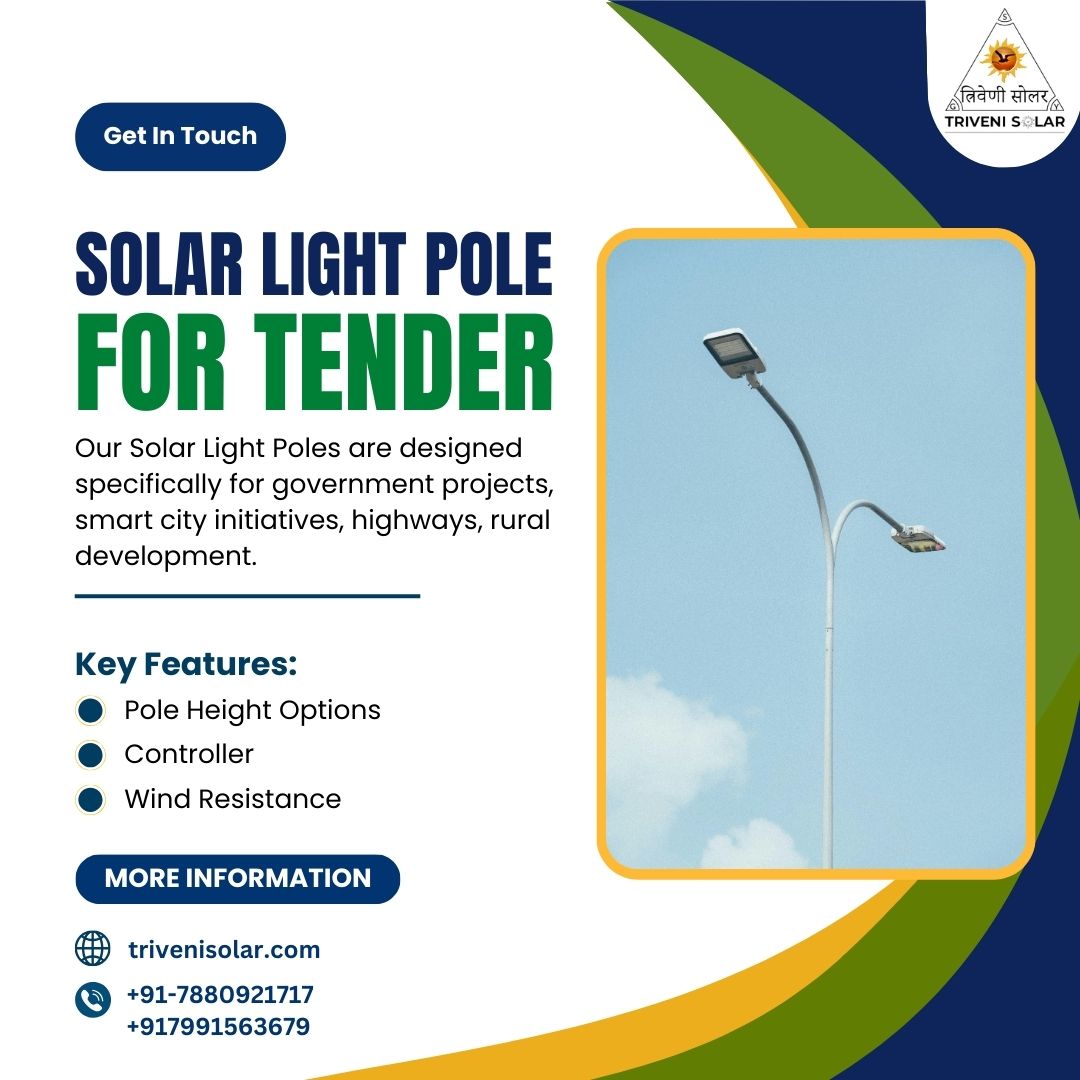Solar street light pole for tenders are specialized lighting solutions designed for government or municipal projects. They meet official specifications, integrate solar panels and batteries, and provide sustainable, low-maintenance street lighting. Choosing the right pole ensures energy efficiency, long-term durability, and successful tender participation.
Table of Contents
- Introduction
- Understanding Solar Street Light Poles
- Key Specifications for Solar Street Light Tenders
- Navigating the Tender Process
- Case Studies: Successful Solar Street Lighting Projects
- Environmental and Economic Benefits of Solar Street Lighting
- Triveni Solar’s Role in Solar Street Lighting Solutions
- Conclusion
- FAQs
Introduction
India is rapidly adopting solar street lighting as a sustainable and cost-effective solution for public infrastructure. With rising energy costs and environmental concerns, solar street light poles have become a preferred choice for government tenders. These poles integrate solar panels, batteries, and energy-efficient LED lighting to illuminate streets, highways, and public areas without depending on the grid.
Understanding the technical specifications, tender requirements, and selection process is crucial for stakeholders, municipalities, and contractors aiming to participate in solar street light tenders.
Understanding Solar Street Light Pole
Components of a Solar Street Light Pole
- Pole Structure: Typically made from galvanized iron (GI) or high-quality steel to ensure durability and withstand environmental conditions.
- Solar Panels: Convert sunlight into electricity and are usually mounted on top or at an optimal angle.
- Battery: Stores energy for night-time illumination; common types include Lithium-ion and Lead-Acid batteries.
- LED Luminaire: Provides efficient lighting with low power consumption.
- Controller: Regulates battery charging, prevents overcharging, and controls light timing.
Types of Poles: GI Poles, High Mast Poles, Decorative Poles
Solar street light poles come in various designs to suit different applications:
- GI Poles: Standard, cost-effective poles for urban and rural streets.
- High Mast Poles: Taller poles used for highways or large open areas.
- Decorative Poles: Aesthetic designs for parks, public squares, and residential areas.


Choosing the Right Solar street light pole for Different Applications
Selecting the appropriate solar street light pole depends on:
- Height requirements and illumination coverage
- Environmental conditions (wind, rainfall, corrosion)
- Type of road or public area
- Compliance with tender specifications
Key Specifications for Solar street light pole for tender
Power Output and Efficiency Standards
Government tenders often specify minimum lumens output and energy efficiency. Ensure LED fixtures meet the recommended lumens per watt and international standards (like LM-80 testing).
Battery Types and Capacity
Batteries should support at least 10–12 hours of nighttime illumination. Lithium-ion batteries are preferred due to longer lifespan and better efficiency.
IP/IK Protection Ratings
IP65 or higher ratings are recommended to protect against dust, water, and external environmental hazards. IK ratings measure mechanical impact resistance.
Solar street light pole Mounting and Installation Requirements
Pole mounting, foundation depth, and tilt angles are critical for tender compliance. Installation must ensure maximum solar exposure for optimal performance.
Solar street light pole Warranty and Maintenance Terms
Provide warranties for at least 3–5 years, including battery replacement and LED maintenance. Maintenance-friendly designs reduce operational downtime.
Solar Street Light Pole Navigating the Tender Process
Finding and Applying for Solar street light pole Tenders
Key platforms to find tenders:
- Government eMarketplace (GeM)
- Tender websites: Tender247, TenderDetail
- Municipal/State government portals
Understanding Tender Documents and Specifications
Thoroughly review tender documents for technical specifications, eligibility criteria, submission deadlines, and evaluation metrics.
Tips for Successful Solar Street Light Pole For Tender Submissions
- Ensure compliance with all specifications
- Provide detailed technical and financial proposals
- Highlight previous project experience and certifications
- Offer competitive pricing while maintaining quality standards
Case Studies: Successful Solar Street Lighting Projects
Case Study 1: Jaipur Municipal Corporation installed over 2,000 solar street lights using high-efficiency GI poles. Result: 40% reduction in municipal electricity bills.
Case Study 2: The Ahmedabad Solar Project implemented decorative poles in public squares. Result: Enhanced aesthetics and 24/7 sustainable lighting.
Environmental and Economic Benefits of Solar Street Lighting
Reduction in Electricity Consumption
Solar sstreetlightsreduce dependence on the grid, lowering energy costs for municipalities and government bodies.
Lower Maintenance Costs
With long-life LEDs and durable batteries, maintenance frequency is minimal compared to conventional street lights.
Contribution to Sustainability Goals
Switching to solar aligns with India’s renewable energy targets and reduces carbon footprint.
Triveni Solar’s Role in Solar Street Lighting Solutions
Overview of Triveni Solar’s Offerings
Triveni Solar provides end-to-end solar street lighting solutions, including poles, LED luminaires, and battery systems optimized for tender requirements.
Certifications and Compliance with Indian Standards
Products are certified as per BIS and MNRE standards, ensuring reliability and quality in government projects.
Why Choose Triveni Solar for Your Projects
- Customizable pole heights and designs
- High-efficiency solar panels and batteries
- Expert guidance for tender documentation and submissions
- Proven track record in multiple Indian cities
Conclusion
Participating in solar street light tenders requires a combination of technical expertise, product quality, and compliance with government specifications. By choosing the right solar street light poles, municipalities and contractors can achieve sustainable, energy-efficient lighting solutions.
Contact Triveni Solar today to explore high-quality solar street light poles designed for tenders and government projects across India.
FAQs
What are the benefits of using solar street light poles over traditional lighting?
Solar street light poles reduce electricity costs, require minimal maintenance, and contribute to environmental sustainability by utilizing renewable energy.
How can I participate in solar street light tenders?
Check platforms like GeM, Tender247, and municipal portals, then follow tender guidelines to submit compliant proposals with technical and financial details.
What are the maintenance requirements for solar street light poles?
Regular cleaning of solar panels, battery health checks, and LED inspections are typically sufficient. Most modern systems are low-maintenance.
How do I choose the right solar street light pole for my project?
Consider height, lumens output, pole material, environmental conditions, and compliance with tender specifications before selecting the pole type.




